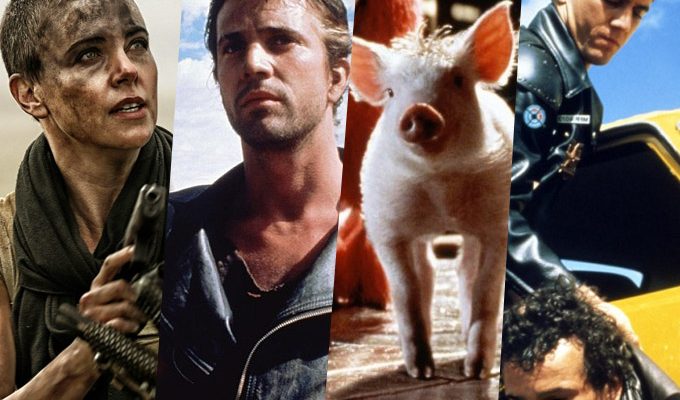
3. “The Witches of Eastwick” (1987)
Here’s the most delightful and in many ways the most entertaining of all Miller’s films. Screenwriter Michael Cristofer, who adapts John Updike‘s novel but makes significant changes in the story to make it a vivid example of feminist cinema, deserves as much credit as Miller in helping “The Witches of Eastwick” remain such a devilishly delicious experience after all these years. Then again, everyone involved is firing from all cylinders, most notably Jack Nicholson, who gives a masterfully comedic performance, Veronica Cartwright, delivering a masterfully deranged performance, and John Williams, whose playful score is some of the composer’s greatest under-the-radar work. The story follows three friends, Alex (Cher), Jane (Susan Sarandon) and Sukie (Michelle Pfeiffer), who live in the fictional Rhode Island town of Eastwick and can make things happen by simultaneous mental effort; be it a change in weather or the appearance of an enigmatic stranger who will sweep them off their feet. Enter insanely rich and carnivorous socialite Daryl Van Horne (Nicholson), who proceeds to seduce all three women and cause controversy in the conservative little town, most potently felt by Felicia (Cartwright), an eminent member of the community. Cristofer’s script puts emphasis on the power play of the male-female dynamic, brought to fantastic life by Nicholson (the scene in church where he delivers a speech about God’s creation of women is right up there next to every one of his Oscar-winning moments) and the three women (Sarandon especially brings out her comedic chops). The increasingly supernatural turn of events in the third act derails the film slightly and taints some of its Coen-esque charm, but the picture remains Miller’s most raucously fun film and a testament to the director’s feminist sensibilities. At beginning of the film, one of the three women says “men are not the answer to everything,” while another finishes with, “so why do we always end up talking about them?” Confronting this notion head-on, “The Witches of Eastwick” is a satire with an insatiable charm.

2. “Mad Max” (1979)
It’s crystal clear, only minutes into “Mad Max”: Miller is going to make a special mark on cinema. The Halls of Justice, shot as if in the twilight of civilization itself, and disconcerting dissolves going through titled cards that warn, “A Few Years From Now…,” amount to perfect examples of how thick the layer of sleaze in this dystopian future really is. Once the Nightrider (Vincent Gil) invades the screen, you feel as if the rails of cinematic convention have become unhinged. It’s a narrative that starts in the middle, with a randomly violent incident, edited with a ferociously kinetic energy that just doesn’t let up, and aptly introduces how the Main Force Police officer Max Rockatansky (a baby-faced Mel Gibson) will one day roam through as the Road Warrior and mercenary-for-hire. As the series’ origin story, “Mad Max” does a spectacularly efficient job on a shoestring budget (reports of the budget range from $350,000 to $600,000 Australian Dollars) and heralds Miller as a director with a natural talent for instilling discomfort into atmosphere, pumping adrenaline into action, and finding just the right balance between on-screen and off-screen violence. The camera slithers, the framing is ever-so-slightly off, and the characters are forever etched into the memory banks: Hugh Keays-Byrne’s Toecutter, an intellectual of the psychotic persuasion; Tim Burns’ Johnny the Boy, who is left with that infamous fate at the end; Roger Ward’s mustachioed and domineering captain Fifi; and of course Max’s wife Jessie (Joanne Samuel) and their boy Sprog (Brendan Heath). For a debut feature, Miller does a whole lot more right than wrong and the quotable script never gets in the way of a strict show-don’t-tell visual approach to storytelling. This is how stars are born, both behind and in front of the camera.

1. “Mad Max 2: The Road Warrior” (1981)
The second installment of a film series typically uses the phenomenal success of its predecessor as creative fuel, and somehow finds a way to one-up it. Like with a few rare examples (“Godfather Part. 2,” possibly “The Empire Strikes Back,” and maybe a couple of others), “Mad Max 2: The Road Warrior” is a sequel that elevates the series onto another level. There’s an immediate sense of a wondrous fable about to unfold, with the voice of Harold Baigent as the narrator and his opening lines; “My life fades, the vision dims. All that remains are memories.” This man chooses his final moments to tell the story of the Road Warrior Max (Mel Gibson), and how this wandering stranger helped his community escape the maniacal clutches of the Humungus (Kjell Nilsson) and his posse of demented men on machines, led by his number-one lap dog Wez (Vernon Wells). In ‘The Road Warrior,’ Miller finds the perfect balance of compassion and nonchalant indifference in Max. With Gibson multiplying the swagger factor and adding subtle hints of emotion into a hardened badass, Miller successfully sculpts one of cinema’s most recognizable iconic antiheroes. His presence emits a legendary aura as soon as the opening mist clears to reveal the injured warrior, his left eye half closed, in an iconic pose. Dean Semler‘s cinematography projects the Australian outback as something extra-terrestrial (one recalls the magnificent wide shot of Humungus’ gang leaving the refinery, and the cosmic scale of their dust trails), and Norma Moriceau‘s gloriously imaginative costumes put the ‘freak’ in freak-show, but it’s Miller’s action that reigns supreme; fluid, operatic and unfathomably unforgiving in its wayward pursuit to represent the psychological consumption of violence. The climactic chase in the final act is one of the greatest pieces of action ever directed, and cements “Mad Max 2” as a gloriously fucked up masterpiece of organic filmmaking.

